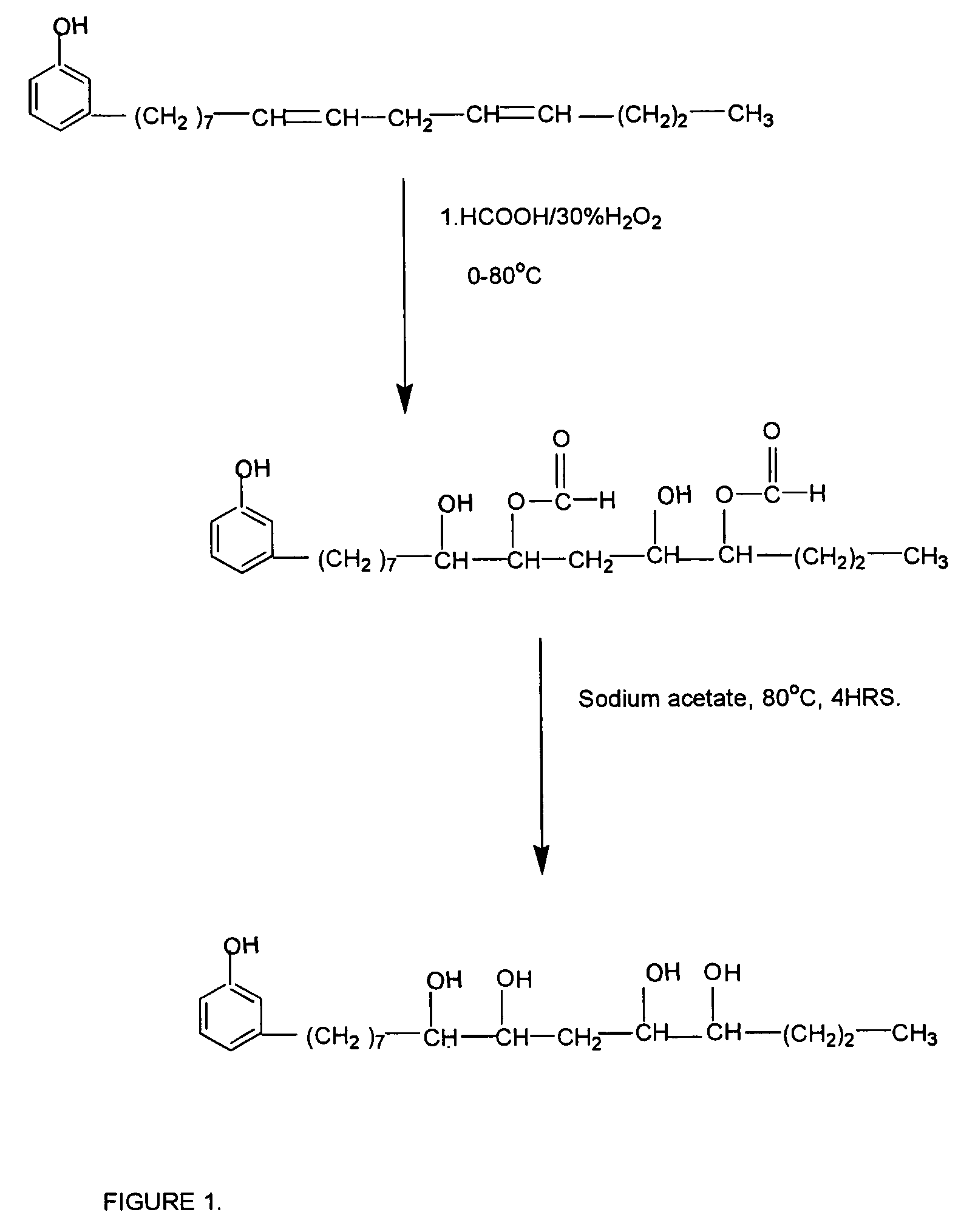Process for preparing polyurethane polyol and rigid foams therefrom
a polyurethane polyol and polyurethane foam technology, applied in the preparation of hydroxy compounds, chemistry apparatus and processes, organic chemistry, etc., can solve the problems of poor hydrolysis resistance and poor abrasion resistance of polyester polyols, and prior art processes that have not been reported with cardanols, etc., to achieve improved mechanical, hydrolytic stability and insulation properties, and high content of hydroxyl groups
- Summary
- Abstract
- Description
- Claims
- Application Information
AI Technical Summary
Benefits of technology
Problems solved by technology
Method used
Image
Examples
example 1
[0031]A mixture of 7.82 g of formic acid [0.17 mole] and 50 g of cardanol [0.17 mole] is taken together in a glass vessel and the mixture under stirring is cooled to 0° C. While stirring continued and maintaining the temperature, 38.5 g (0.34 mole) of 30% H2O2 is added drop wise from a pressure equalizing funnel. The addition time required 5–10 hours. During addition the temperature is maintained by a cooling bath.
[0032]After completion of the addition, the reaction temperature is increased to 35° C., whereby the epoxy groups present is converted to hydroxyl-formoxy ester. The half ester so produced is hydrolyzed with sodium acetate at 80° C. for 4 hours. The product is neutralized, washed with excess water till neutral to litmus and dried over anhydrous sodium sulphate.
example 2
[0033]A mixture of 20 g of formic acid [0.57 mole] and 151 g of cardanol [0.5 mole] is taken together in a glass vessel and the mixture under stirring is cooled to 0° C. while stirring continued and maintaining temperature 116 g 30% (1.02 mole) H2O2 is added drop wise from a pressure equalizing funnel. The addition is completed in 5–10 hours. During addition the temperature is maintained by a cooling bath.
[0034]After the complete addition, the reaction temperature is increased to 35° C., whereby the epoxy groups present is hydrolyzed to hydroxyl-formoxy ester. The half ester so produced is hydrolyzed with sodium acetate at 80° C. for 4 hours. The product is neutralized, washed with excess water till neutral to litmus and dried over anhydrous sodium sulphate.
example 3
[0035]In another example a mixture of 19 g of formic acid [0.6 mole] and 150 g of cardanol [0.5 mole] is taken together in a glass vessel and the mixture stirred at cooled to 0° C. while stirring continued and maintaining temperature 115 g 30% (1.02 mole) H2O2 is added drop wise from a pressure equalizing funnel. The addition is required 5–10 hours. During addition the temperature is maintained by ice cooling at 24–32° C.
[0036]After complete addition, the reaction temperature is increased to 35° C., whereby the epoxy groups present is hydrolyzed to hydroxyl-formoxy ester. The half ester so produced is hydrolyzed with sodium acetate at 80° C. for 4 hours. The product is neutralized, washed with excess water till neutral to litmus and dried over anhydrous sodium sulphate.
[0037]The mineral acid catalyst such as conc H2SO4 is used in an amount 0.05% to 5% on the weight of cardanol. At the end of the reaction the product is taken in a separating funnel washed with excess of water till ne...
PUM
| Property | Measurement | Unit |
|---|---|---|
| temperature | aaaaa | aaaaa |
| viscosity | aaaaa | aaaaa |
| reaction temperature | aaaaa | aaaaa |
Abstract
Description
Claims
Application Information
 Login to View More
Login to View More - R&D
- Intellectual Property
- Life Sciences
- Materials
- Tech Scout
- Unparalleled Data Quality
- Higher Quality Content
- 60% Fewer Hallucinations
Browse by: Latest US Patents, China's latest patents, Technical Efficacy Thesaurus, Application Domain, Technology Topic, Popular Technical Reports.
© 2025 PatSnap. All rights reserved.Legal|Privacy policy|Modern Slavery Act Transparency Statement|Sitemap|About US| Contact US: help@patsnap.com

